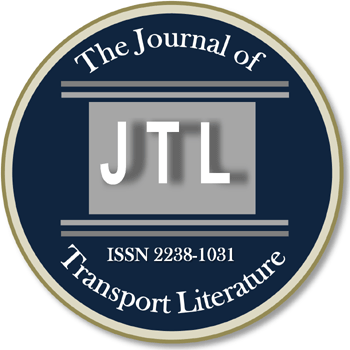Resumos
Este artigo apresenta simulações de curvas de ruído utilizando o programa INM (Integrated Noise Model) e Transcad com o objetivo de verificar as áreas onde a população que reside nas vizinhanças do aeroporto é afetada pelo aumento do tráfego aéreo e mudanças climáticas. Este estudo foi motivado pelas reclamações junto ao Ministério Público pela população residente no entorno do aeroporto. Os resultados mostram variações significativas na população afetada com a mudança da posição das curvas isofônicas entre 55 e 65 dB(A) e menos significativas acima de 65 dB(A). Entende-se que simulações permitem estimar ordem de grandeza do impacto das aeronaves nas vizinhanças do aeroporto norteando futuros levantamentos de dados reais. As divergências de uma simulação com valores reais podem ser geradas pelo não seguimento dos padrões estabelecidos nas cartas de voo, ventos de direções diversas e a não inclusão do relevo da região. Os resultados mostraram que modificações nos procedimentos de pouso e decolagem podem mitigar a poluição sonora.
simulação com INM; população afetada pelo ruído
This article presents simulations of curves of aircraft noise using the INM (Integrated Noise Model) program as well as the Transcad, in order to identify the areas in the surroundings of the airport where the population is more affected by the increase of the aircraft traffic and the climate changes. This study was initiated after the complaints made by the population living in the surroundings of the airport and received by the Prosecuting Office. The overall results indicated substantial variations in the population affected by the changes in the position of the isophonic curves between 55 and 65 dB(A) and a less expressive effect above 65dB(A). Simulations like those performed here allow one to estimate the magnitude order of the impact of aircrafts in the surroundings of the airport, guiding future data collections in the field. Discrepancies between the predicted data and the field data can be caused by noncompliance to the standards established by the flight charts, by winds of different directions and the disregard of the surrounding relief. The results showed that modifications to the landing and takeoff procedures can mitigate noise pollution.
simulation with INM; population affected by noise
- Associação brasileira de normas técnicas – NBR 11415 (1990) Ruído aeronáutico
- Berglund, B., Lindvall, T. e Schwela, D. H. (1999) Guidelines for community noise: Prepared for the World Health Organization, London.
- Caliper (2007) TransCAD transportation GIS software: User's guide. Version 4.8 Massachusetts: Academic License, Newton.
- Damião, D. P. e Rocha, A. (1998) Utilização de dados de sensoriamento remoto no planejamento urbano do entorno de aeródromos: Anais IX Simpósio brasileiro de sensoriamento remoto, Santos.
- Dani, A., Garavelli, S. L. (2001) Principais Efeitos da Poluição Sonora em Seres Humanos. Revista Universa, vol. 9, n. 14, pp. 659-678.
- Departamento de Controle do Espaço Aéreo – DECEA (2010), Sítio da internet, disponível em www.decea.gov.br
- Federal Aviation Administration (FAA) (2004) Part 150 Noise compatibility program
- Federal Aviation Administration (FAA) (1983) Noise control and compatibility planning for airports. Advisory circular AC150-5020-1, U. S. Department of transportation, Washington.
- Fernandes, J. C. (2002) Acústica e ruído. Apostila do Curso de Especialização em Engenharia de Segurança do Trabalho UNESP – Campus de Bauru.
- Figueiredo Ferraz Consultoria e Engenharia de Projetos Ltda (2005) Estudo de impacto ambiental – Aeroporto Leite Lopes. Documento técnico, São Paulo.
- Horonjeff, R and McKelvey, F. (1993) Planning and a design of airports Forth edition, McGrawHill.
- Instituto Brasileiro de Geografia e Estatística - IBGE (2000) Censo Demográfico 2000 Rio de Janeiro: IBGE.
- ICAO - CAN (1970) Committee on aircraft noise
- ICAO (1993) Environmental protection, Annex 16, volume 1: aircraft noise, Third edition, Montreal.
- ICAO (2001) Apêndice C da A33-7: Consolidated statement of continuing ICAO policies and practices related to environmental protection, pp. 15-17.
- ICAO (2002) Airport planning manual – Land use and environmental control DOC 9184 AN/902 – Part 2, Third edition, Montreal.
- ICAO (2004) Environmental technical manual on the use of procedures in the noise certification of aircraft Doc 9501 AN/929, Third Edition. Quebec.
- Macedo, M. R. V. (2004) Avaliação pós-ocupação acústica: um instrumento de apoio ao planejamento e gestão ambiental na circunvizinhança de pequenos aeroportos. Tese (Doutorado em Engenharia de Produção), Universidade Federal do Rio de Janeiro, Rio de Janeiro.
- Nogueira, R. C. C. e Slama, J. G., (2005) Implementing the balanced approach for airport noise control in developing countries: the case of Brazil. Proceedings of the Internoise, Rio de Janeiro.
- Olmstead, J. R., Fleming, G. G., Gulding, J. M., Roof, C. J., Gerbi, P. J. e Rapoza, A. S. (2002) Integrated noise model (INM) Version 6.0 Technical manual, Report FAA-AEE-02- 01, Office of environment and energy, Federal Aviation Administration.
- Revoredo, T. C. (2011) Estimação dinâmica do ruído aeronáutico utilizando sistemas diferencialmente planos e redes neurais artificiais. Tese (Doutorado em Engenharia Mecânica),Universidade Federal do Rio de Janeiro Rio de Janeiro.
- Society of Automotive Engineers (1986) SAE AIR 1845. Procedure for calculation of airplane noise in the vicinity of airports Warrendale.
- Vallet, M. (2002) Acoustic pollution due to aircraft traffic and the ways to reduce it. Euronoise, Madrid.
- Werlich, J. M. and Krinsky, R. P. (1981) The aviation noise abatement controversy: Magnificent laws, noisy machines, and the legal liability shuffle, Loyola of Los Angeles Law Review, vol. 15.
- World Health Organization (WHO) (2010) International society of hypertension guidelines for the management of hypertension Guidelines Subcommittee.
- World Health Organization (WHO) (1999) Guide lines for community noise London, Stockholm University and Karolinska Institute.
Datas de Publicação
-
Publicação nesta coleção
31 Jan 2014 -
Data do Fascículo
Jan 2014
Histórico
-
Recebido
03 Jul 2012 -
Aceito
28 Jan 2013 -
Revisado
25 Jan 2013

